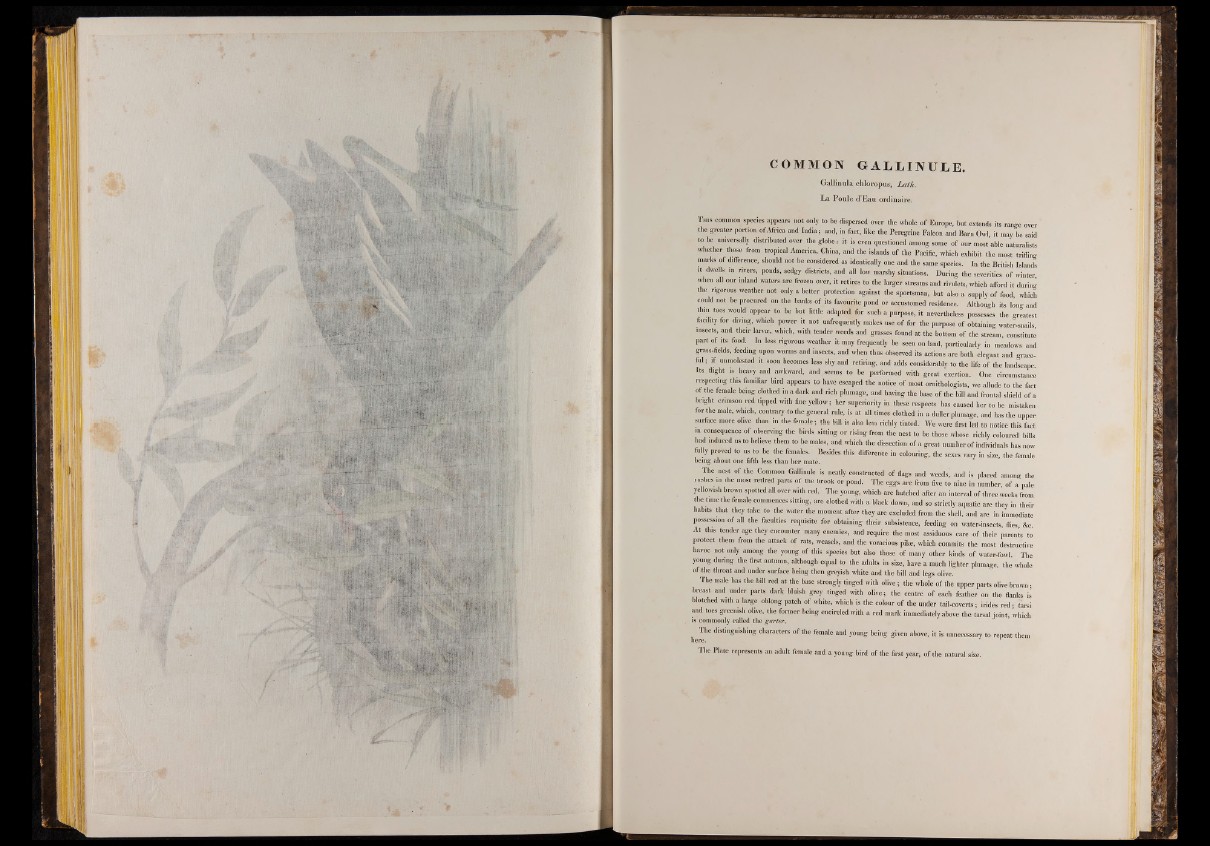
S i
COMMON GALLINULE .
G a llin u la ch loropu s, L a th .
L a P o u le d’E a u ordinaire.
T h is common species appears not only to be dispersed over the whole o f Europe, but extends its range over
the greater portion o f Africa and India; and, in fact, like the Peregrine Falcon and Barn Owl, it may be said
to be universally distributed over the globe: it is even questioned among some of our most able naturalists
whether those from tropical America, China, and the islands o f the Pacific, which exhibit the most trifling
marks o f difference, should not be considered as identically one and the same species. In the British Islands
it dwells m rivers, ponds, sedgy districts, and all low marshy situations. During the severities o f winter,
when all our inland waters are frozen over, it retires to the larger streams and rivulets, which afford it during
thss rigorous weather not only a better protection against the sportsman, but also a supply o f food, which
could not be procured on the banks o f its favourite pond or accustomed residence. Although its long and
thin toes would appear to be but little adapted for such a purpose, it nevertheless possesses the greatest
facility for diving, which power it not unfrequently makes use o f for the purpose o f obtaining water-snails
insects, and their larvie, which, with tender weeds and grasses found at the bottom o f the stream, constitute
part o f its food. In less rigorous weather it may frequently he seen on land, particularly in meadows and
grass-fields, feeding upon worms and insects, and when thus observed its actions are both elegant and graceful
; i f unmolested it soon becomes less shy and retiring, and adds considerably to the life o f the l . - W .
Its flight is heavy and awkward, and seems to he performed with great exertion. One circumstance
respecting this familiar bird appears to have escaped the notice o f most ornithologists, we allude to the fact
of the female being clothed in a dark and rich plumage, and having the hase o f the bill and frontal shield o f a
bright crimson red tipped with fine yellow; her superiority in these respects has caused her to be mistaken
for the male, which, contrary to the general rule, is at all times clothed in a duller plumage, and has the upper
surface more olive than in the female; the bUl is also less richly tinted. We were first led to notice this feet
in consequence o f observing the birds sitting or rising from the nest to be those whose richly coloured bills
had induced us.to believe them to be males, and which the dissection o f a great number o f individuals has now
fully proved to us to be the females. Besides this difference in colouring, the sexes vary in size, the female
being about one fifth less than her mate.
The nest o f the Common Gallinule is neatly constructed o f flags and weeds, and is placed among the
rushes in the most retired parte o f the brook or pond. The eggs are from five to nine in number o f a pale
yellowish brown spotted all over with red. The.yoitng, which are hatched after an interval o f three weeks from
thghme-the female commences sitting, are clothed with a black down, and so strictly aquatic are they in their
habits that they take to the water the moment after they are excluded from the shell, and are in immediate
possession o f all the faculties requisite for obtaining their subsistence, feeding on water-insects, flies, &c.
A t this tender age they encounter many enemies, and require the most assiduous care o f their parents to
protect them from the attack o f rats, weasels, and the voracious pike, which commits the most destructive
havoc not only among the young o f this species but also those o f many other kinds o f water-fowl The
young during the first autumn, although equal to the adults in size, have a much lighter plumage the whole
of .the throat and under surface being then greyish white and the bill and legs olive.
The male has the bill red at the base strongly tinged with olive; the whole o f the upper parts olive brown;,
breast and under parts dark bluish grey tinged with olive; the centre o f each feather on the flanks is
blotched with a large oblong patch o f white, which is the colour o f the under tail-coverts; ¡rides red ; ¿ r s i
and toes greenish olive, the former being encircled with a red mark immediately above the tarsal joint, which
is commonly called the garter.
^ The distinguishing characters o f the female and young being given above, it is unnecessary to repeat them
The Plate represents an adult female and a young bird o f the first year, o f the natural size.